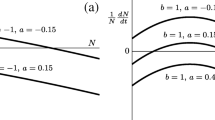Summary
The dynamics of density-dependent population models can be extraordinarily complex as numerous authors have displayed in numerical simulations. Here we commence a theoretical analysis of the mathematical mechanisms underlying this complexity from the viewpoint of modern dynamical systems theory. After discussing the chaotic behavior of one-dimensional difference equations we proceed to illustrate the general theory on a density-dependent Leslie model with two age classes. The pattern of bifurcations away from the equilibrium point is investigated and the existence of a “strange attractor” is demonstrated — i.e. an attracting limit set which is neither an equilibrium nor a limit cycle. Near the strange attractor the system exhibits essentially random behavior. An approach to the statistical analysis of the dynamics in the chaotic regime is suggested. We then generalize our conclusions to higher dimensions and continuous models (e.g. the nonlinear von Foerster equation).
Similar content being viewed by others
References
Arnold, V. I.: Ordinary Differential Equations. Cambridge, Mass.: M.I.T. Press 1973.
Auslander, D., Oster, G., Huffaker, C.: Dynamics of interacting populations. J. Franklin Inst. 1974.
Beddington, J.: Age distribution and the stability of simple discrete time population models (preprint, 1975).
Beddington, J., Free, C. A.: Age structure, density dependence and limit cycles in predator-prey interactions. Theo. Popln. Biol. (to appear, 1975).
Beddington, J., Free, C., Lawton, J.: Dynamic complexity in predator-prey models framed in difference equations. Nature 255, 58–60 (1975).
Bowen, R.: Equilibrium States and the Ergodic Theory of Anosov Diffeomorphisms. (Lecture Notes in Mathematics, Vol. 470.) New York: Springer 1975.
Bowen, R., Ruelle, D.: The ergodic theory of axiom A flows. Inv. Math. 1975.
Gurtin, M., MacCarmny, R.: Non-linear age-dependent population dynamics. Arch. Rat'l. Mech. Anal. 54, 281–300 (1974).
Hassell, M., Lawton, J., May, R.: Pattern of dynamical behavior in single-species populations (preprint, 1975).
Hopf, E.: Abzweigung einer periodischen Lösung eines Differentialsystems. Akad. Wiss. Leipzig 94, 1–2 (1942).
Hoppenstead, F., Hyman, J.: Periodic solutions of a logistic difference equation. SIAM Regional Conf., Univ. of Iowa. 1975.
Howard, R.: Dynamic Probabilistic Systems. Vol. 1: Markov Models, Vol. 2: Semi-Markov and Decision Processes. New York: J. Wiley 1971.
Katz, A.: Principles of Statistical Mechanics: The Information Theory Approach. San Francisco: W. H. Freeman 1967.
Keyfitz, N.: Introduction to the Mathematics of Populations. Reading, Mass.: Addison-Wesley 1968.
Kifer, Ju. I.: On small random perturbations of some smooth dynamical systems. Math. USSR Izvestija 8 (5), 1083–1107 (1974).
Krebs, C. J.: Ecology. New York: Harper and Row 1972.
Leslie, P. H.: On the use of matrices in certain population mathematics. Biometrika 35, 183–212 (1945).
Leslie, P. H.: Some further notes on the use of matrices in population mathematics. Biometrika 35, 213–245 (1948).
Li, T.-Y., Yorke, J. A.: Period three implies chaos. Amer. Math. Monthly (to appear, 1975).
Lorenz, E.: Deterministic non-periodic flows. J. Atmos. Sci. 20, 130–141 (1963).
Marsden, J., McCracken, M.: The Hopf Bifurcation. (Lecture Notes in Mathematics.) New York: Springer 1976.
May, R. M.: Biological populations with nonoverlapping generations: stable points, stable cycles, and chaos. Science 186, 645–647 (1974).
May, R.: Stability and Complexity in Model Ecosystems, 2nd ed. Princeton Univ. Press 1975.
May, R., Oster, G.: Bifurcations and Dynamic Complexity in Simple Ecological Models. Amer. Natur (to appear, 1975).
Metropolis, N., Stein, M., Stein, P.: Stable states of a non-linear transformation. Numerische Mathematik 10, 1–9 (1967).
Metropolis, N., Stein, M., Stein, P.: On finite limit sets for transformations on the unit interval. J. Combinatorial Theory 15 (1), 25–43 (1973).
Myberg, P. J.: Iteration der realen Polynome zweiten Grades III. Ann. Acad. Scientiarium Fennicae. Ser. A 336, 1–18 (1963).
Newhouse, S. E.: Diffeomorphisms with infinitely many sinks. Topology 12, 9–18 (1974).
Oster, G., Auslander, D., Allen, T.: 1976.
Oster, G., Takahashi, Y.: Models for age specific interactions in a periodic environment. Ecological Monographs 44, 483–501 (1974).
Oster, G., Guckenheimer, J.: Bifurcation Behavior of Population Models, in: The Hopf Bifurcation (Marsden, J., McCracken, M., eds.). New York: Springer 1976.
Pennycuick, C., Compton, R., Beckingham, L.: A computer model for simulating the growth of two interacting populations. J. Theo. Biol. 18, 316–329 (1968).
Pielou, E. C.: An Introduction to Mathematical Ecology. New York: Wiley-Interscience 1969.
Ruelle, D., Takens, F.: On the nature of turbulence. Comm. Math. Phys. 20, 167–192 (1971).
Sinai, Ja. G.: Gibbs measures in ergodic theory. Russian Math. Surveys 27 (4), 21–70 (1972).
Smale, S.: Diffeomorphisms with Many Periodic Points, in: Differential and Combinatorial Topology (Cairns, S., ed.), p. 6380. Princeton Univ. Press 1965.
Stein, P., Ulam, S.: Non-linear transformation studies on electronic computers. Rozprawy Metamatyczne 39, 401–484 (1964).
Trucco, E.: Mathematical models for cellular systems: the von Foerster Equation, Part I: Bull. Math. Biophys. 27, 285–303, Part II: 27, 449–471 (1963).
Usher, M. B.: Developments in the Leslie Matrix Model, in: Mathematical Models in Ecology (Jeffers, J. N. R., ed.). Oxford: Blackwell 1972.
Varley, G., Gradwell, G., Hassell, M.: Insect Population Ecology. Berkeley: Univ. of California Press 1974.
Williamson, M.: The Analysis of Biological Populations. London: Edward Arnold Ltd., New York: Crane, Russak and Co. 1972.
Author information
Authors and Affiliations
Additional information
Supported by NSF Grant No. BMS 74-21240.
Rights and permissions
About this article
Cite this article
Guckenheimer, J., Oster, G. & Ipaktchi, A. The dynamics of density dependent population models. J. Math. Biology 4, 101–147 (1977). https://doi.org/10.1007/BF00275980
Received:
Issue Date:
DOI: https://doi.org/10.1007/BF00275980




